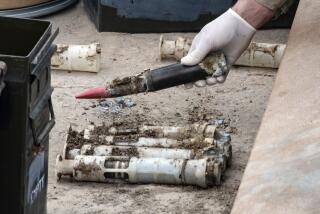Well-Armed and Very Dangerous
- Share via
As NATO mounts its air campaign against Yugoslavia, much has been made of the mismatch of the combatants’ conventional weapons capabilities. Although that imbalance is unlikely to change, too little attention has been given to Belgrade’s weapons of mass destruction potential. In the near term, this danger principally involves chemical weapons. A longer-term, but not distant, threat relates to nuclear arms.
Before the breakup of socialist Yugoslavia in 1991, its army had an advanced chemical weapons program dating back to the 1960s. According to the late Croatian Gen. Zlatko Binenfeld, Yugoslavia produced the deadly nerve agent sarin, mustard gas, the choking agent phosgene, the hallucinogenic incapacitant BZ and tear gases. These toxic chemicals were put into a variety of munitions, including artillery shells, aerial bombs, rockets and chemical mines.
Much of the former Yugoslavia’s offensive chemical weapons infrastructure, production capacity and expertise was inherited in 1991 by the Federal Republic of Yugoslavia (Serbia and Montenegro). Three of the four known chemical weapons production facilities in the former Yugoslavia were on Serbian territory, and equipment from the fourth such plant, near Mostar, Bosnia, was reportedly dismantled by Yugoslav troops and moved to Serbia in 1992.
Yugoslavia maintains a significant chemical defense posture. An offensive capability also may have been demonstrated during the Bosnian war, which saw repeated allegations of the use by the Bosnian Serbs of Yugoslav-supplied tear gas and BZ. Moreover, Belgrade has refused to sign the 1993 Chemical Weapons Convention banning development, possession and use of chemical arms.
In contrast to the immediate chemical threat posed by Yugoslavia, the principal nuclear danger is prospective. It derives from more than 50 years of Yugoslav nuclear science research, a large and well-trained cadre of nuclear scientists and engineers, a stock of weapons-usable material and a history of at least two prior efforts during the Tito regime to acquire nuclear arms.
The latest of these attempts to “go nuclear” was launched immediately after the first Indian nuclear detonation in 1974 and appears to have been abandoned by the early 1980s. Much of the infrastructure to support a nuclear weapons program remains intact, however, and is concentrated at the Vinca Institute of Nuclear Science near Belgrade. These nuclear assets include a 6.5-megawatt research reactor, 48 kilograms of weapons-usable uranium (80% U-235) and extensive experience with uranium enrichment and plutonium reprocessing. Although to date the Milosevic regime has done nothing to suggest that it plans to resume a nuclear weapons program, the proliferation incentives for Yugoslavia may grow as it assumes the position of a pariah state--a profile closely resembling that of other nuclear weapons aspirants such as South Africa in the past and Iraq and North Korea today.
The longer and more successful the NATO air campaign against Yugoslavia, the greater the temptation for Belgrade to consider a nonconventional weapons response. This action might involve the terrorist use of chemical weapons or radioactive material against the Kosovo Albanians or NATO peacekeepers in Bosnia and Macedonia. The Milosevic government might also seek to acquire the funds needed to bolster its conventional arsenal by trafficking in chemical weapons, nuclear material and associated production equipment.
To counter these potential threats, NATO and the international community should undertake the following steps:
First, NATO peacekeeping forces in the region must be prepared for possible hostilities involving chemical weapons use. Second, increased scrutiny should be given to Yugoslav chemical and nuclear trade with would-be proliferators. Third, as part of any cease-fire settlement, Belgrade should be required to sign and ratify the Chemical Weapons Convention and to accept strengthened international safeguards at its nuclear facilities. Finally, the U.S. and Russia must revive their traditional but increasingly frayed cooperation in halting the spread of weapons of mass destruction. In the case of Yugoslavia, this cooperation might take the form of a U.S.-subsidized “buy-back” by Moscow of the Soviet-origin nuclear material at Vinca.
The technical and political obstacles to the development and employment of weapons of mass destruction by Yugoslavia are not as great as often assumed. Unless this danger is recognized and steps are taken to counteract it, we may soon experience another shock to the nonproliferation regime.
More to Read
Sign up for Essential California
The most important California stories and recommendations in your inbox every morning.
You may occasionally receive promotional content from the Los Angeles Times.













